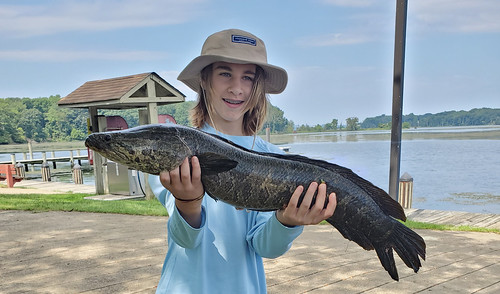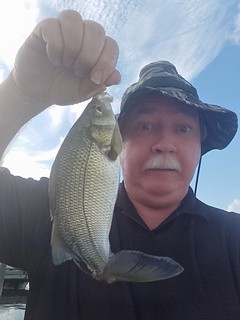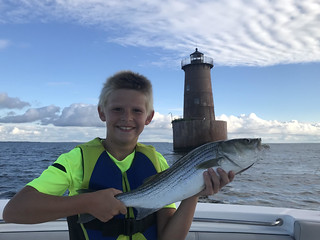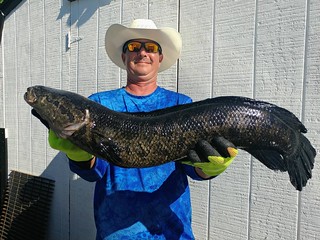
Brayden Castigilia holds up a northern snakehead he caught recently near Smallwood State Park. Photo courtesy of Katy Kaufmann
Mother Nature is dealing Maryland some hot daytime temperatures this week, and many of those seeking some relief will flock to the water. Fishing for a variety of freshwater and saltwater fish could hardly be better as we approach the zenith of our summer fisheries, from the cool mountain streams of Western Maryland to the warmer waters of the Chesapeake Bay and Atlantic coast.
One fish that has been providing a lot of fun and exciting action are northern snakeheads. This invasive species is certainly plentiful and they are rapidly expanding their range, making them available to anglers throughout the Chesapeake watershed.
As the summer heat continues, please continue checking the Maryland striped bass fishing advisory forecast to help protect this iconic species.

Forecast Summary: August 25 – August 31:
Another sunny week, with continued warm weather, will result in Maryland Bay water temperatures remaining stable. Bay surface water, river, and stream temperatures are still very warm and holding in the low 80s. Monitoring data is showing main Bay bottom waters are still slightly cooler than surface waters, and continue to show some poor oxygen conditions. As a result, Bay gamefish will likely be higher in the water column to find adequate oxygen and their preferred water temperatures. The coolest oxygenated bottom waters can be found from the Kent Island area north to Tolchester.
Adequate oxygen levels are found at all depths from the Susquehanna Flats to Still Pond. Due to low bottom oxygen levels, avoid fishing below the following depths in these locations: Swan Point, 20 feet; Bay Bridge to Bloody Point, 15 feet to 20 feet; Choptank River to Point No Point, 15 feet to 35 feet. On the Potomac River from Colonial Beach to Piney Point, avoid fishing deeper than 15 feet to 35 feet. Conditions can vary daily so be sure to check the depth-to-oxygen level online prior to your next fishing trip to check your specific location.
Expect average flows for most Maryland rivers and streams. There will be above average tidal currents through Saturday due to the recent Aug. 22 full moon. Expect average clarity for Maryland portions of the Bay and rivers, with very poor water clarity due to algal blooms in the Northeast, Bush, Back, middle Patuxent, middle Sassafras, upper Chester, and Choptank rivers. To see the latest water clarity conditions, check Eyes on the Bay Satellite Maps.
For more detailed and up-to-date fishing conditions in your area of the Bay, check the Maryland DNR website for Click Before You Cast. Get regular updates on Maryland’s waters sent to your inbox with our Eyes on the Bay newsletter. Sign up online.
Upper Chesapeake Bay

Roy Wheeler took this fun selfie with a white perch he caught in Bear Creek. Photo by Roy Wheeler
Anglers accustomed to casting into the relatively quiet Conowingo Dam pool at dawn may need to adjust their strategy. The dam has been releasing large amounts of water on a 24-hour schedule this past week, so anglers should be careful when trying to fish the dam pool or the Susquehanna River below the dam. The good news is that a lot of cool water is moving down the Susquehanna River.
Fishing for striped bass in the vicinity of the Susquehanna Flats remains good. Sunrise is occurring later now so it is a bit easier to get out on the water early, which is necessary to enjoy the topwater water action along the edges of the Susquehanna Flats. As the morning wears on there is good success for those jigging along the channel edges or live-lining spot.
Elsewhere in the upper Bay, the striped bass that were holding at the various Tolchester Lumps are showing signs of spreading out to other locations. There are still a good number of boats anchoring up on many of the lumps and live-lining spot. The morning hours with a good running tide continue to be two important factors for success. The percentage of undersized striped bass continues to be high so anglers are urged to release all fish in the water and to discontinue fishing once catching the limit of one legal-sized fish. Ongoing hot air temperatures and warm water temperatures is not good for catch-and-release survival of striped bass. Anglers are urged to review the best catch and release practices before fishing for striped bass on the Department of Natural Resources website. Anglers are also required to use circle hooks when targeting striped bass, to help prevent deep hooking when fishing with bait or live-lining.
Striped bass are being found in many upper Bay locations this week for those live-lining, jigging or trolling the Key Bridge and the mouth of the Patapsco River, the mouth of the Magothy River, the Love Point Rocks, and the various channels at the mouth of the Chester and Sassafras rivers. Live-lining spot is perhaps the most popular way of fishing, followed by jigging soft plastics. Trolling umbrella rigs with medium-sized bucktails dressed with curly tails is a good way to cover water along channel edges. Single-rigged bucktails can work well in shallower channel edges.
Fishing is good for a mix of blue catfish, flathead catfish, and channel catfish in the lower Susquehanna and surrounding rivers this week. Fresh-cut menhaden or gizzard shad are two of the most common baits used. Blue catfish and channel catfish can be found in all of the upper Bay tidal rivers, often in the middle to upper sections this time of the year.
White perch fishing remains very good in the lower sections of the region’s tidal rivers and creeks. Casting small spinners and beetle spins in the morning and evening hours near shoreline structure offers a lot of fun, and the fish offer some wonderful eating. Fishing with a bottom rig baited with pieces of bloodworms in the deeper portions of the tidal rivers and out in the Bay over hard bottom shoals and reefs works well also.
Middle Bay
Spanish mackerel are providing a lot of fun and exciting fishing action this week in the middle Bay. The Spanish mackerel are spread from Kent Island south, with the most popular locations to find them in the Bloody Point and Buoy 83 area, in front of Chesapeake Beach, and the False Channel. They are feeding on schools of bay anchovies with their sidekicks, small bluefish, and occasionally small striped bass in tow.

Charlie Merchant went fishing with his dad recently and caught this nice striped bass while jigging near Bloody Point Light. Photo by Scott Merchant
Often the mackerel will chase schools of bait to the surface, with diving seagulls moving in and marking the action for anglers scanning the horizon. Finding slicks can offer a window into recent action, and fish can be spotted holding deep on depth finders. Casting small jigs and speed-reeling them through the action is a great way to catch the Spanish mackerel.
Trolling can be a good way to cover water in search of Spanish mackerel along channel edges. Small Drone spoons in gold with chartreuse color added are one of the most popular lures, pulled behind planers at speeds close to 8 knots. Clark spoons are a good addition to a trolling spread and some spoons can also be pulled behind inline weights with good results.
Fishing for striped bass in the middle Bay has been good lately in a variety of methods. The early morning and evening shallow water fishing scene along shoreline structure has been providing plenty of fun topwater fishing and casting paddletails. The Eastern Bay, Poplar Island, the mouth of the Severn River. and the Choptank River are just a few locations that are providing good fishing.
Jigging along channel edges has been good, and anglers often will spot suspended striped bass on their depth finders before jigging with soft plastics. The Bay Bridge Piers, Thomas Point, Bloody Point, and shipping channel edges are all good places to investigate.
Anglers targeting striped bass this week are also anchoring up near the Bay Bridge piers, live-lining spot or drifting soft crab baits near the bases of the piers. Live-liners are also active at Thomas Point and the outside edge of Hacketts.
White perch continue to be a fun target for anglers of all ages. Casting small spinners and beetle spins along the shores of the tidal rivers and the Bay is a fun summertime activity in the morning and evening hours. Using small jig heads or bottom rigs with grass shrimp is an excellent way to fish for white perch around docks and piers. Fishing with bottom rigs over live oyster bottom in the lower sections of the tidal rivers can also provide good white perch action.
Anyone who comes near the waters of the Chesapeake and the tidal rivers in the past month have been dealing with sea nettles, or jellyfish. Those little buggers that foul fishing lines and lures also manage to sting no matter how careful one tries to be. NOAA’s Ocean Prediction Center offers a website that tracks the spread of sea nettles through the Chesapeake Bay system.
Lower Bay
The lower Bay is providing a lot of exciting fishing opportunities this week for several species of fish. Spanish mackerel lead the list but red drum, cobia, bluefish and bottom species such as white perch, spot, and croaker are also offering plenty of action.

Eric Packard and Bryan Meade hold up a pair of legal sized red drum caught in the lower Potomac. Photo by Eric Packard
Spanish mackerel are being found from the western side of the Bay to Tangier Sound and north to the middle Bay. They tend to congregate along the edges of the shipping channel as they chase schools of bay anchovies and juvenile menhaden. Trolling is certainly popular with small Drone and Clark spoons behind planers at about 7 to 8 knots along channel edges, but casting into breaking fish offers exciting action. Carefully moving upwind of breaking fish, then casting jigs into the fray and retrieving quickly offers fun light-tackle action.
Fishing for large red drum continues to offer exciting catch-and-release action. Trolling large spoons behind inline weights is one method. Spotting slicks from feeding red drum offers the opportunity to either jig with large soft plastics or to drop a soft crab bait down to the fish. The Mud Leads, Target Ship area, Point Lookout, and the Middle Grounds are good places to look for the large red drum.
Anglers casting for striped bass using paddletails and soft plastic jigs along shoreline structure areas of Tangier Sound, the western side of the Bay, and channel edges in the lower Potomac River are also finding red drum this week — some falling within the legal slot size of 18 inches to 27 inches. The morning and evening hours tend to provide the best fishing action. Striped bass are part of the mix and speckled trout catches have dropped off in the past couple of weeks.
Boats are anchoring up at the Target Ship and Smith Point this week and chumming for cobia. The action tends to be reported as a slow pick but it only takes one fish to make one’s day. Most are chumming with ground menhaden and sending the chum out sparingly. Cut menhaden baits are commonly used, or live eels that are allowed to settle back into the depths of the chum slick. Most have learned by experience to keep a stout spinning rod rigged with a large soft plastic jig nearby, in case a cobia shows up close to the boat.
A few anglers have had success trolling large tube lures behind inline weights for cobia, and adding a large spoon or two in hopes of some catch-and-release action with large red drum. When the Bay waters are slick, sight-casting is a very effective and exciting way to fish for cobia. A flying bridge is extremely helpful to spot the surface cruising fish, with a live eel or large soft plastic jig ready to be cast to the fish.
Those wishing to bottom fish for spot and white perch are experiencing good fishing in the lower Patuxent River, areas around Point Lookout, Cobb Island on the lower Potomac River, and the Tangier Sound. Many of the spot are large enough to provide good eating. The white perch are plentiful and a few of the croakers being caught meet the minimum size. Most are using a mix of bloodworms and peeler crab baits on bottom rigs.
Recreational crabbing continues to move along at a relatively slow pace as compared to previous years, but most crabbers can catch a half-bushel of good crabs per outing. The largest crabs — often 7 inches or larger — are being caught in deeper waters, often as deep as 15 feet. Smaller crabs that measure 5 inches to 6 inches are being caught in shallower waters. The best catches are coming from the middle Ba tidal rivers. The recent rain events seem to have moved crabs farther down the tidal rivers from where they were holding a few weeks ago. Razor clams and chicken necks continue to be the most popular baits.
Freshwater Fishing
Due to recent rain events most of the trout management waters in the western and central regions are flowing well. The cooler shaded waters of the region’s trout waters can be very inviting for any angler seeking some relief from the oppressive heat. This time of the year also presents a fun challenge to fool educated trout with a variety of terrestrial flies and nymphs.

Donavin Petre caught this whopper of a northern snakehead in Sue Creek off the Middle River recently. Photo courtesy of Donavin Petre
The Department of Natural Resources trout hatchery program is always busy and last month crews were out stocking juvenile trout in the western region. About 4,500 juvenile rainbow trout were stocked in the Youghiogheny catch-and-release area.
The warm water hatchery program has been busy stocking juvenile largemouth bass, but also recently released 265,000 juvenile American shad in the upper Choptank River near Denton and 40,000 in the upper Tuckahoe Creek below Hillsboro. In recent years these areas have provided wonderful catch-and-release fishing for hickory shad, and these stockings hold promise for the larger American shad as well.
The upper Potomac River is stable with typical summer flows, which are usually low with clear water. Careful approaches, light lines, and long casts are in order when targeting holes and submerged ledges for smallmouth bass. Small crankbaits, tubes and soft plastic jigs tend to be favored baits. Hatchery crews recently stocked 695 smallmouth bass fingerlings in the upper Potomac near Seneca Landing to bolster smallmouth bass populations.
The largemouth bass fishery continues to chug along in the typical summer mode of behavior. September will bring on changes in fishing, as waters begin to cool. This week though, the tactics are to be out at dawn if you want to fish the shallows with topwater lures. Frogs are a great way to cover water without getting snagged, and chatterbaits can also be a good choice. As largemouth bass retreat to thick grass in deeper waters for cool shade, dropping wacky rigged stick worms or soft plastic down through the grass usually works well. In tidal waters working the edges of grass mats or spatterdock fields with spinnerbaits and small crankbaits on a low ebb tide can work well.
Northern snakeheads will be part of the mix for anyone fishing in the tidal waters of the Chesapeake Bay. Some will be caught while fishing for largemouth bass and others by anglers purposely targeting northern snakeheads. This time of the year the snakeheads are holding close to grass waiting to ambush anything that looks good to eat. Noisy lures such as chatterbaits and frogs are great baits to use over grass. In open water edges it is hard to beat a white paddletail.
Deep structure in the form of sunken wood, bridge piers or deep grass is a great place to find lounging bass looking for cooler waters and some shade. Small crankbaits and grubs can be good choices to search these areas. If structure can be pinpointed, slowly working soft plastic craws or other soft plastic baits can entice a pickup.
This is a great time of the year to fish with light tackle for bluegill sunfish. Casting small rubber-legged poppers or ants with a light fly rod is a wonderful summer evening activity. Fishing with small jigs or creature baits under a bobber is another fun way to fish for them. For the younger set, it is hard to beat a mealworm, cricket, or worm under a bobber.
Atlantic Ocean and Coastal Bays

Photo by Monty Hawkins
Due to the summer heat, some of the best surf fishing for the common mix of kingfish, spot, croaker, and small bluefish is occurring during the morning hours. The daytime heat and bright sun are tough on both fish and anglers. Pieces of bloodworm and Fishbites are the favored baits when fishing for kingfish and spot. Croaker will take either bloodworms or squid, while bluefish like cut spot.
At the inlet and Route 50 Bridge area, there is plenty of fun striped bass fishing during the morning and evening hours. Most of the striped bass being caught are falling short of the minimum 28 inches but a few keepers are being caught. Casting jigs and bucktails near the South Jetty is a popular way to fish. Flounder are being caught in the inlet along with bluefish.
In the back bay areas, flounder are the primary target and they are being caught in the channels leading towards the Ocean City Inlet. Traditional baits of squid and minnows are catching their fair share of flounder. There are a lot of undersized flounder being caught and released. Those targeting the larger flounder are using live spot or mullet and Gulp baits.
Outside the inlet there are Spanish mackerel being caught near the various shoals, Little Gull has been popular lately. Trolling Drone and Clark spoons behind inline weights and planers is the most popular way to target the Spanish mackerel. Bluefish can also be part of the mix.
The offshore wreck and reef sites continue to provide excellent fishing for black sea bass. Generally speaking this has been a wonderful sea bass season for anglers. Flounder are part of the mix and at times small dolphin are being caught to the delight of anglers up and down the rails on Ocean City party boats.
A real milestone was set recently offshore of Ocean City. Maryland has seen its third “grander” blue marlin caught and it has become our new state record at 1,135 pounds! Any blue marlin over 1,000 pounds is a very big deal no matter where it is caught around the world, and it is a fish of a lifetime for any angler.
“Then the fish came alive, with his death in him, and rose high out of the water showing all his great length and width and all his power and his beauty. He seemed to hang in the air above the old man in the skiff. Then he fell into the water with a crash that sent spray over the old man and over all of the skiff. ” —
Ernest Hemingway, “The Old Man and the Sea”
Maryland Fishing Report is written and compiled by Keith Lockwood, Maryland Department of Natural Resources fisheries biologist.
Click Before You Cast is written by Tidewater Ecosystem Assessment Director Tom Parham.
This report is now available on your Amazon Echo device — just ask Alexa to “open Maryland Fishing Report.”
